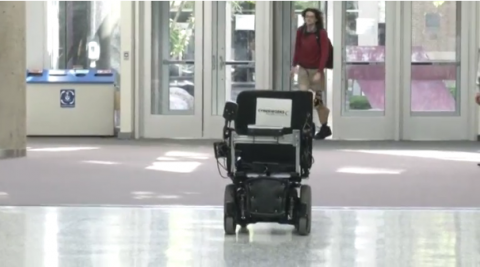
TORONTO, Canada (Reuters) — Autonomous wheelchair technology that could be retrofitted to any existing electric wheelchair for less than $1,000 USD has been developed by Canadian firm Cyberworks Robotics, Inc and researchers at the University of Toronto (U of T).
The technology combines inexpensive off-the-shelf sensors and artificial intelligence.
Electric wheelchairs have been around for more than 60 years but their fundamental technology has changed little.
“Conventional electric powered wheelchairs use joysticks for their control and are really hard to use, even for able-bodied users, let alone those with physical disability,” project innovator Maya Burhanpurkar, a student at Harvard University, told Reuters.
“Alternative input devices, like Sip and Puff switches, are even more challenging to use, so we wanted to apply self driving car technology to a wheelchair to give users greater mobility, independence, and quality of life.”
Engineering Professor Jonathan Kelly, who co-ordinated the project that also included researchers from the Université de Sherbrooke in Quebec, explained how the software works.
“We use RGB-D sensors, which project light into the scene and then reads that light back, giving information about how far away obstacles are. That information is then encoded into a 2D map, which added to some additional 3D information, lets users know where it’s safe to drive, where it’s safe to travel, and where not to travel based on potential obstacles,” said Kelly.
He says that users with conditions like multiple sclerosis, amytrophic lateral sclerosis (ALS) or spinal cord injuries will find the technology particularly useful.
“A caregiver or therapist would simply drive the chair around and the chair would acquire a map to use as a basis for its future navigation. Once that map is built it can be turned over to the user who would be able to pick destinations, for example going from the living room to the kitchen, and have the chair take them there entirely automatically,” he said.
Users could choose from a list of these pre-selected locations using either a traditional joystick or Sip-and-Puff controller. They can also choose to activate the system in locations that have not been previously mapped in order to complete certain automated tasks, such as traversing a doorway or docking the wheelchair at a desk.
Maya Burhanpurkar, a globally recognised innovator for her previous work, created an algorithm that enables the wheelchair to traverse a doorway with just 2 centimetres of clearance on either side.
She says the team’s technology is superior to that of other groups working on self-driving wheelchairs who rely on high-end, expensive, sensors.
“Many are using sensors costing tens of thousands of dollars that would never be affordable to a consumer. Our technology uses cost effective sensors and computing hardware, which means it’s something that could be commercially viable now,” she said.
If a sensor detects a person or obstacle in the immediate path of a user, the wheelchair has been programmed to stop. Upon detection of any kind of failure condition or situation the autonomous system cannot handle, it performs a controlled handover to the user so the chair can be used in normal manual mode.
The project has been a work in progress at Cyberworks since the 1980s. Two years ago, the company’s founder and CEO,approached Kelly with a view to collaborate.
A decision was taken early on to devise a system that could be retrofitted to existing wheelchairs.
“Tens of millions of people already own power wheelchairs and we felt that we should design something that they can use on their existing wheelchairs, avoiding the expense of having to buy a completely new wheelchair,” said Vivek Burhanpurkar.
He added: “For people with severe mobility problems this is a real gamechanger.”
The wheelchair has been tested, without an occupant, in a variety of locations. The next step will be to test the system with wheelchair users in controlled environments under the supervision of occupational therapists.
The team believes regulatory approval should follow quickly, allowing many millions of wheelchair users world-wide to be helped within five years.
Cyberworks is working on extending the technology to other manually driven machines, such as hospital floor scrubbers which could be used to clean hospitals on a 24/7 basis at lower costs.








